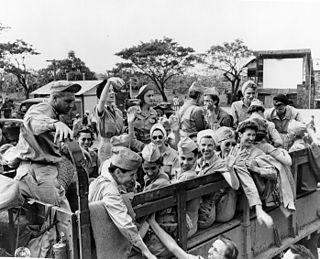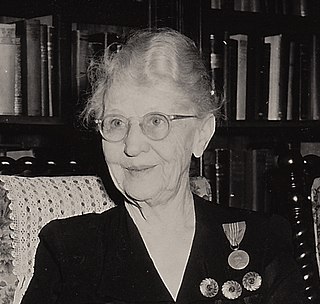Recorded Jewish history in the Philippines started during the Spanish period.

The Topaz War Relocation Center, also known as the Central Utah Relocation Center (Topaz) and briefly as the Abraham Relocation Center, was an American concentration camp in which Americans of Japanese descent and immigrants who had come to the United States from Japan, called Nikkei were incarcerated. President Franklin Roosevelt signed Executive Order 9066 in February 1942, ordering people of Japanese ancestry to be incarcerated in what were euphemistically called "relocation centers" like Topaz during World War II. Most of the people incarcerated at Topaz came from the Tanforan Assembly Center and previously lived in the San Francisco Bay Area. The camp was opened in September 1942 and closed in October 1945.

The Curragh Camp is an army base and military college in The Curragh, County Kildare, Ireland. It is the main training centre for the Irish Defence Forces and is home to 2,000 military personnel.
A civilian internee is a civilian detained by a party to a war for security reasons. Internees are usually forced to reside in internment camps. Historical examples include Japanese American internment and internment of German Americans in the United States during World War II. Japan interned 130,000 Dutch, British, and American civilians in Asia during World War II.

Margaret Elizabeth Doolin "Peggy" Utinsky was an American nurse who worked with the Filipino resistance movement to provide medicine, food, and other items to aid Allied prisoners of war in the Philippines during World War II. She was recognized in 1946 with the Medal of Freedom for her actions.

John Hay Air Station, more commonly known as Camp John Hay, was a military installation in Baguio, Philippines.
Ilag is an abbreviation of the German word Internierungslager. They were internment camps established by the German Army in World War II to hold Allied civilians, caught in areas that were occupied by the German Army. They included United States citizens caught in Europe by surprise when war was declared in December 1941 and citizens of the British Commonwealth caught in areas engulfed by the Blitzkrieg.

Batu Lintang camp at Kuching, Sarawak on the island of Borneo was a Japanese-run internment camp during the Second World War. It was unusual in that it housed both Allied prisoners of war (POWs) and civilian internees. The camp, which operated from March 1942 until the liberation of the camp in September 1945, was housed in buildings that were originally British Indian Army barracks. The original area was extended by the Japanese, until it covered about 50 acres. The camp population fluctuated, due to movement of prisoners between camps in Borneo, and as a result of the deaths of the prisoners. It had a maximum population of some 3,000 prisoners.

Stanley Internment Camp was a civilian internment camp in Hong Kong during the Second World War. Located in Stanley, on the southern end of Hong Kong Island, it was used by the Japanese imperial forces to hold non-Chinese enemy nationals after their victory in the Battle of Hong Kong in December 1941. About 2,800 men, women, and children were held at the non-segregated camp for 44 months from early January 1942 to August 1945 when Japanese forces surrendered. The camp area consisted of St Stephen's College and the grounds of Stanley Prison, excluding the prison itself.

The Angels of Bataan were the members of the United States Army Nurse Corps and the United States Navy Nurse Corps who were stationed in the Philippines at the outset of the Pacific War and served during the Battle of the Philippines (1941–1942). When Bataan and Corregidor fell, 11 navy nurses, 66 army nurses, and 1 nurse-anesthetist were captured and imprisoned in and around Manila. They continued to serve as a nursing unit while prisoners of war. After years of hardship, they were finally liberated in February 1945.

The Weixian Internment Camp, better known historically as the Weihsien Internment Camp, was a Japanese-run internment camp called a "Civilian Assembly Center" in the former Wei County, located near the city of Weifang, Shandong, China. The compound was used by the Japanese during World War II to intern civilians of Allied countries living in North China. The camp operated from March 1943 until October 1945 and more than 2,200 civilians were interned for all or part of the time the camp was open.
The Hunters ROTC was a Filipino resistance group that fought against Axis forces in the Pacific theater. It was a guerrilla unit active during the Japanese occupation of the Philippines, and was the main anti-Japanese resistance group active in the area near Manila, the capital of the Philippines. It was created upon the dissolution of the Philippine Military Academy.

Santo Tomas Internment Camp, also known as the Manila Internment Camp, was the largest of several camps in the Philippines in which the Japanese interned enemy civilians, mostly Americans, in World War II. The campus of the University of Santo Tomas in Manila was utilized for the camp, which housed more than 3,000 internees from January 1942 until February 1945. Conditions for the internees deteriorated during the war and by the time of the liberation of the camp by the U.S. Army many of the internees were near death from lack of food.

Wauwilermoos was an internment camp and prisoner-of-war penal camp in Switzerland during World War II. It was situated in the municipalities of Wauwil and Egolzwil in the Canton of Lucerne (Luzern). Established in 1940, Wauwilermoos was a penal camp for internees, including Allied soldiers, among them members of the United States Army Air Forces, who were sentenced for attempting to escape from other Swiss camps for interned soldiers, or other criminal offences. Together with Hünenberg and Les Diablerets, Wauwilermoos was one of three Swiss penal camps for internees that were established in Switzerland during World War II. The intolerable conditions were later described by numerous former inmates and by various contemporary reports and studies.
Horace Bristol Pond was an American business executive, philanthropist, American Red Cross personnel, World War II prisoner, and an expatriate in Manila, Philippines.
Gladys Becker Slaughter, Madame Savary, was an American woman of Manila who labored long and hard to help the starving, neglected, abused, and threatened "internees" at Santo Tomas Internment Camp, supplying them with food every day and performing various other services, such as laundry, communication and monetary assistance, to help ease their hardship. At the same time, she also worked hard to help her servants and friends outside of Santo Tomas survive the Japanese occupation of the Philippines and the 1945 Battle of Manila. Gladys was not incarcerated by the Japanese because, being married to a Frenchman, she was regarded as a citizen of France which by that time had a puppet government aligned with Japan's ally Germany. Gladys also sent help to a POW camp. Several of her activities could have resulted in torture and execution had she been caught. She maintained a diary throughout the Japanese occupation, and made this the basis of her book Outside the Walls.

Beulah Ream Allen was an American nurse, physician, and civilian physician during World War II. After graduating with a nursing degree in 1922, she worked as a supervising nurse and headed the educational department for the LDS Hospital in Salt Lake City. She worked as a hospital inspector for the state of Utah until 1928, when she moved to San Francisco to attend medical school. While earning her degree at the University of California, San Francisco, she worked as a nurse in the Bay Area. Upon her graduation in 1932, she moved to the Philippines, where she opened a medical practice.

Nancy Belle Craft Norton was employed by the U.S. Government to teach at Manila High School in the Philippines when war with Japan was declared in 1941. During the Japanese occupation of the Philippines, she aided internees and prisoners of war by supplying them with urgently needed medical supplies, food, clothing and other items. General Jonathan M. Wainwright personally awarded her the Medal of Freedom in 1947 for her efforts during the war.

Valeria "Yay" Panlilio (1913–1978), known as Colonel Yay, was an American/Filipina journalist, radio announcer, and guerrilla leader during World War II in the Philippines. After the war she married the commander of Marking Guerrillas, Marcos Villa Agustin. She was awarded the United States Medal of Freedom for her wartime activities.














